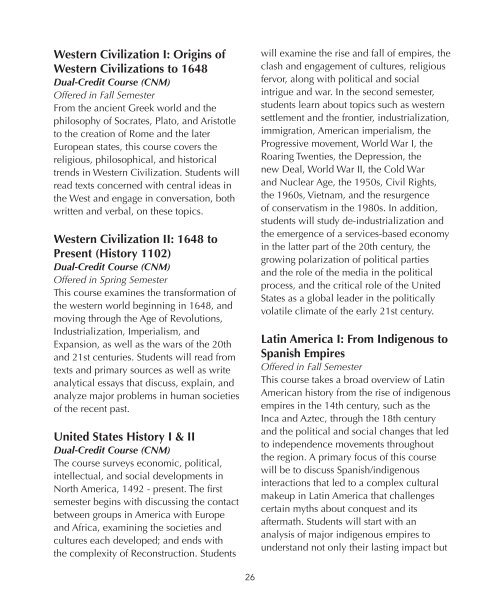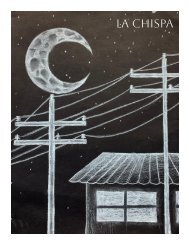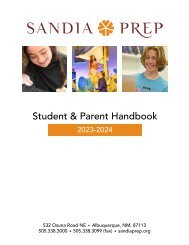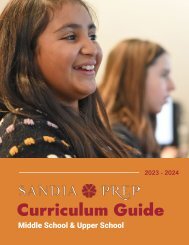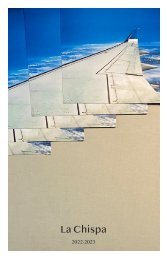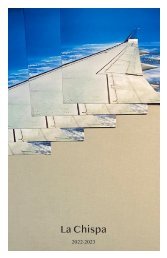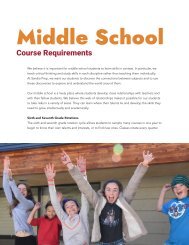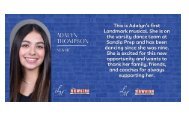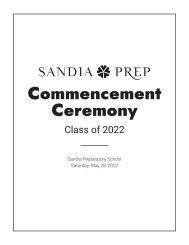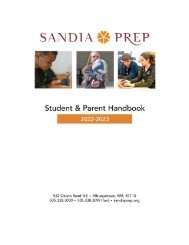Curriculum Guide 2020-2021
Sandia Prep Curriculum Guide: 2020 - 2021
Sandia Prep Curriculum Guide: 2020 - 2021
You also want an ePaper? Increase the reach of your titles
YUMPU automatically turns print PDFs into web optimized ePapers that Google loves.
Western Civilization I: Origins of<br />
Western Civilizations to 1648<br />
Dual-Credit Course (CNM)<br />
Offered in Fall Semester<br />
From the ancient Greek world and the<br />
philosophy of Socrates, Plato, and Aristotle<br />
to the creation of Rome and the later<br />
European states, this course covers the<br />
religious, philosophical, and historical<br />
trends in Western Civilization. Students will<br />
read texts concerned with central ideas in<br />
the West and engage in conversation, both<br />
written and verbal, on these topics.<br />
Western Civilization II: 1648 to<br />
Present (History 1102)<br />
Dual-Credit Course (CNM)<br />
Offered in Spring Semester<br />
This course examines the transformation of<br />
the western world beginning in 1648, and<br />
moving through the Age of Revolutions,<br />
Industrialization, Imperialism, and<br />
Expansion, as well as the wars of the 20th<br />
and 21st centuries. Students will read from<br />
texts and primary sources as well as write<br />
analytical essays that discuss, explain, and<br />
analyze major problems in human societies<br />
of the recent past.<br />
United States History I & II<br />
Dual-Credit Course (CNM)<br />
The course surveys economic, political,<br />
intellectual, and social developments in<br />
North America, 1492 - present. The first<br />
semester begins with discussing the contact<br />
between groups in America with Europe<br />
and Africa, examining the societies and<br />
cultures each developed; and ends with<br />
the complexity of Reconstruction. Students<br />
will examine the rise and fall of empires, the<br />
clash and engagement of cultures, religious<br />
fervor, along with political and social<br />
intrigue and war. In the second semester,<br />
students learn about topics such as western<br />
settlement and the frontier, industrialization,<br />
immigration, American imperialism, the<br />
Progressive movement, World War I, the<br />
Roaring Twenties, the Depression, the<br />
new Deal, World War II, the Cold War<br />
and Nuclear Age, the 1950s, Civil Rights,<br />
the 1960s, Vietnam, and the resurgence<br />
of conservatism in the 1980s. In addition,<br />
students will study de-industrialization and<br />
the emergence of a services-based economy<br />
in the latter part of the 20th century, the<br />
growing polarization of political parties<br />
and the role of the media in the political<br />
process, and the critical role of the United<br />
States as a global leader in the politically<br />
volatile climate of the early 21st century.<br />
Latin America I: From Indigenous to<br />
Spanish Empires<br />
Offered in Fall Semester<br />
This course takes a broad overview of Latin<br />
American history from the rise of indigenous<br />
empires in the 14th century, such as the<br />
Inca and Aztec, through the 18th century<br />
and the political and social changes that led<br />
to independence movements throughout<br />
the region. A primary focus of this course<br />
will be to discuss Spanish/indigenous<br />
interactions that led to a complex cultural<br />
makeup in Latin America that challenges<br />
certain myths about conquest and its<br />
aftermath. Students will start with an<br />
analysis of major indigenous empires to<br />
understand not only their lasting impact but<br />
26


